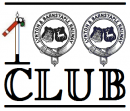Tablet Instruments Update May 2023
L&BR member Malcolm Kitchen has provided us with another chapter in the fascinating story of his labour of love in restoring Tyer's Tablet Machines
Two instrument histories.
Tyer’s Number 6 tablet instruments normally come in one of four standard configurations, denoted by A,B,C or D. The configuration is determined by the shape of a slot in the edge of the tablets which matches the shape of a keyway within the storage cylinder and slide of the instruments that issue or receive the tablets. Other non-standard configurations are occasionally found and one of the instruments purchased by the L&B Trust some time ago has a very unusual configuration (see Figs 1 and 2)
The instrument comes from the Petrockstow-Torrington section of the North Devon and Cornwall Junction Light Railway - confirmed by comparing the unusual instrument configuration with photos of extant tablets. As the instrument is labelled as being located at the ‘up’ end of the single line section, it must have resided in Torrington signal box. The ND&CJLR opened in 1925 and, because of the unusual configuration, this instrument may have been newly manufactured at that time. See also https://en.wikipedia.org/wiki/North_Devon_and_Cornwall_Junction_Light_Ra...
Fig 1 ex ND&CJLR instrument
Fig 2 Tablet slide showing recesses for two configuration pins.
Comparing with tablets for this section at https://www.gwra.co.uk/auctions/tyers-brass-single-line-tablet-torringto... and https://sremg.org.uk/location/torrington_03.html , it can be seen that the tablets were inserted into the instrument face down.
Another instrument that has been rebuilt recently is believed to come from Taynuilt signal box on the Callendar and Oban line in Scotland (see http://www.oban-line.info/equip.html ). It is made for use with square tablets with several key components being peculiar to such instruments. This also appears to be an early No6 instrument, lacking several of the later refinements. Since the L&B Trust only has one example of this sub-type, its potential for future use in Devon is very limited and realistically, it would be more suited to display in a museum.
Figs 3 and 4 – Front and back views of ex-Taynuilt instrument
Fig 5 – An Edwardian hardwood cable grommet - one of ten in the back panel. An example of Tyer’s work on details that, in a normal installation, would be completely hidden from view.
Two resurrected instruments
A further two instruments have been assembled from the available spares and are now almost complete. These incorporate some castings that had been badly broken, probably as a result of instruments being knocked over or dropped. Along with repairs to the castings, several smaller components were missing and have had to be remade. The opportunity has been taken to rewire these instruments to separate the power supply for the ‘local’ devices – the bell and the electric locks – from the ‘remote’ or line supply that operates the polarising relay in the instrument at the other end of the single line section. The separation facilitates the use of a line supply voltage higher than the nominal 12V if necessary to counteract voltage drop over a long line. The opportunity has been taken to add an internal 15W heater within the case fed from the local supply, with a switch and indicator light on the rear panel.
Fig 6 – repaired instrument
Fig 7 – heater, back panel and new terminal block
Two Tyer’s makers plates
A couple of L&B tablet instruments have lost their distinctive Tyer’s makers plates at some point in their long history. The North Dorset Railway (who also have several Tyer’s No 6 instruments) recently commissioned Joe Rose of Rose and Rose Visualisations to produce some replica 3-D printed plates. Two of these replicas have been purchased and when fitted, are barely distinguishable from the cast brass originals.
Fig 8 - replica Tyer’s makers plate
Two more Tablet Instrument stands
Some more donations of good quality wood offcuts have been received and these have been recycled into two more cabinet stands for tablet instruments. As most of the wood was mahogany or sapele, it seemed a crime to cover it all up with Southern Rly green paint, so they have been given an oiled finish. One of the stands is of reduced height in case one is needed for a location in a signal box where the signalman needs to have clear line of sight over the top of the instrument.
Fig 9 - New tablet instrument stands
































